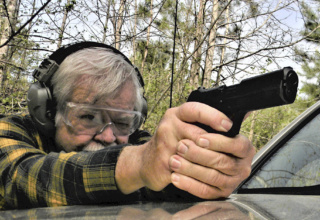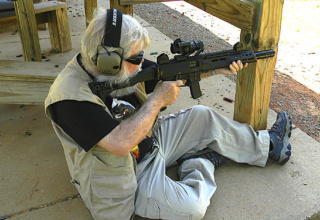Whether Steel Challenge or home range bragging rights, SIG Sauer has you covered with the P322 and P322-COMP
by David Kelley
Varieties of action-shooting have overtaken many precision pistol disciplines in the last few decades. Whether shooting recreationally with local leagues or competitively at a national organization level, Americans have turned to events where speed and accuracy on reactive targets are favored over slow-paced, single-distance paper punching. Shooting on the move or relatively stationary fire at a mix of paper and steel targets has also increasingly drawn shooters arriving with rimfire pistols. Many local clubs are offering a “bring what ya’ got” class, allowing a rimfire shooter to fire the same course as centerfires on USPSA/IPSC type events. Other clubs and organizations have implemented rimfire-dedicated courses of fire and match events, an example being Rimfire Challenge Shooting Association, formerly the NSSF Rimfire Challenge.
With the increase in popularity of matches and unarguable increase in rimfire usage driven by ammunition and component cost inflation — along with general availability shortages — SIG Sauer has recently added a modded-up version of their popular P322 rimfire pistol. Labeled as the P322-COMP, the updated model takes the 2022-released pistol to the next level with features directly oriented towards those running a 22LR on competitive shooting courses.
The P322 and P322-COMP
The P322 was a ground-up development from SIG. The pistol was not based on any previous models and is a stand-alone design in their lineup. Both the P322 and P322-COMP frames are polymer, with a hard coat anodized alloy slide housing a 4-inch suppressor-ready barrel and are internal hammer-fired (single-action-only). A flat and curved trigger are shipped with both models with easy instructions to swap if you prefer one over another. Other similarities are a fiber optic front sight, M1913 accessory rail, and ambidextrous safety. Each model is optic-ready, and that is where the P322-COMP shows the first measurable difference; the COMP includes a factory-mounted SIG ROMEOZero Elite optic.
In addition to the factory-included optic, there are several notable inclusions on the P322-COMP. Starting at the muzzle end, SIG added a removable two-port compensator that cleanly matches the slide dimensions. Moving to the center of the handgun, you’ll find the COMP model wearing an oversized takedown lever that is designed to be used as a thumb shelf for the non-firing hand of right-handed shooters. Southpaws are out of luck — the takedown lever is constricted to the left side of the pistol, though the extended mag release included with the COMP is reservable, as is the standard-sized magazine release of the P322. The final addition to the P322-COMP is the “slide racker” mounted behind the ROMEOZero optic on the rear of the slide. This is a great feature to pull back the slide quickly and easily without relying on the slide serrations.
Range Time and Impressions
I was able to secure a bench at a local indoor range to zero both handguns and to familiarize myself with each pistol prior to a second day outdoor session. A hasty rest was set with sandbags benched on the 50-ft. line. As shipped, the P322-Comp was impacting less than 5 inches right of point-of-aim and elevation was spot on. Per the manual, the ROMEOZero is shipped with a mechanical zero, and this close-to-center initial group confirmed that all-around tolerances of mounting plate and barrel alignment are good-to-go. Following a quick sight shift with the provided .050-in. Allen wrench, some base usage of the optic was accomplished. Following the user manual, the optic is self-explanatory.
There is one button tucked under the sight housing to the rear of lens that is used as an on/off switch and a rheostat control for eight levels of dot brightness. My only gripe with the ROMEOZero is not avoidable with a micro sight — my fingers are cumbersome with small controls. That is the price to pay with a small, minimalist optic, yet it was easy enough to manipulate with a small flathead driver instead of my finger. The CR1632 battery provides two years of runtime.
Initial groups sandbagged at 50-ft. hovered right around 1.5-2 inches for ten shots with 40-gr. CCI Standard Velocity and RWS Target Pistol ammo. Federal 36-gr. Copper Plated Hollow Points (Value Packed) opened up to the 2.5+-inch range due to more fliers in each group than the other two varieties tested. The time on the bags and scale showed that the triggers both have approximately .300 inches of take-up/slack, hit a nice noticeable wall, and then break at 3.5 lbs. through the second “stage.”
On the second day, outdoor shooting in frigid Northwestern Pennsylvania weather commenced. I was able to fire approximately 400 rounds between the two pistols with most fired from the P322-COMP, only firing the standard P322 to identify any immediate function issues along with getting a feel for the iron-sighted gun right alongside the red dot and comped model.
During the outdoor session, rounds were fired through a mix of slow, sustained, and rapid fire — both single- and two-handed. The two 20-round magazines provided with the P322 and the 20- and 25-round magazines shipped with the P322-COMP were especially useful as magazine reloading time in cold weather was greatly reduced.
For being relatively light pistols, both recovered well in rapid fire. In my opinion, the P322-COMP settled back onto target slightly faster. The P322-COMP fired single-hand did not rise at the muzzle near as much as the standard model sans compensator — I’d estimate close to a 50% reduction by watching the front sight rise at recoil. It seems that the minor additional weight at the muzzle end does what it is intended to do. Firing with two hands felt that the standard model had a slightly reduced recoil push. The best I can describe is that the standard model felt less “snappy” even though it didn’t recover back on target as quickly. This feel could be the cause of a different spring weight, added momentum of the slide from the mounted optic, or a placebo effect. Regardless, I assure you there was a slightly different feel, and one wasn’t better or worse than the other.
Overall, I found both to be reliable in the limited time I had to handle each. One “stovepipe” was experienced in the P322-COMP during the first several magazines fired using Federal copper-plated ammo. More time would tell, but I’m confident it was a mild combination of bullet nose profile, a specific magazine, and initial wear that was needed. After 100 rounds, I could not get the pistol to replicate the random malfunction. With that said, the lead round nose of CCI Standard Velocity and RWS Target Pistol did not fail to feed one single time though the sessions.
The P322-COMP does what is was designed to do: rapidly and reliably put accurate rounds on a target. The thumb shelf at dual grip, easy to manipulate slide, provided optic, and reduced muzzle jump all equate to good scores and a good time.
This pistol is labeled “COMP,” but if the additional features compared to the standard P322 benefit you, don’t hesitate to use the hot-rodded model as a plinker, training tool to teach a youngster proper handling and introduction to shooting sports, or to use as your own trainer instead of burning your precious supply of centerfire ammunition. Street price difference between the two is under $250, which is very reasonable considering the optic price alone is half of that.
Also, check out the SIG website for some great instructional videos centered on the P322 series.
Sig P322-COMP Specifications
- Chamber: 22LR
- Action: SAO
- Pistol Size: Compact
- Trigger Type: flat/curved (both included)
- Grip: compact polymer
- Barrel Material: carbon steel
- Frame Material: stainless steel
- Slide Material: alloy
- Slide Finish: clear anodized
- Manual Safety: Yes
- Optic Ready: Yes
- Sights: ROMEOZero ELITE 3 MOA red dot
- Footprint: Compact (Shield RMS-c)
- Threaded Barrel: yes
- Overall Length: 8 in.
- Overall Width: 2.2 in.
- Height: 6.1 in.
- Barrel Length: 4 in.
- Weight: 19.8 oz. w/magazine
- Sight Radius: 6 in.
- Accessory Rail: M1913
- Mags Included: (1) 20-rd. / (1) 25-rd.
- Suppressor Considerations for First Time “Can” Buyers - December 13, 2024
- FIELD TEST: Benelli M2 Field - June 3, 2024
- FIRST TEST: Springfield Armory SA-16 A2 Rifle - April 30, 2024

























